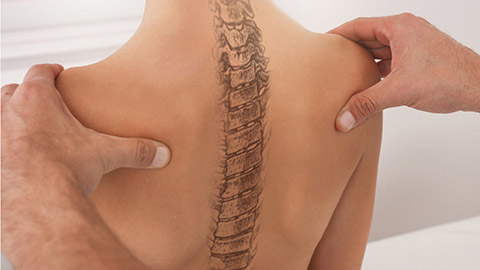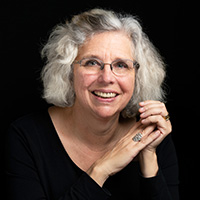
A competitive barrel racer has multiple back surgeries for scoliosis. She has spinal fusions and Harrington rods that stabilize and immobilize her spine from her sacrum all the way up to T2. With her massage therapist’s help, she makes a big discovery about her function. Human bodies are amazing!
Resources:
Brooks, W. J., Krupinski, E. A., and Hawes, M. C. (2009). “Reversal of Childhood Idiopathic Scoliosis in an Adult, Without Surgery: A Case Report and Literature Review.” Scoliosis 4, no. 27 (2009). https://doi.org/10.1186/1748-7161-4-27.
Dalton, Erik. “Scoliosis and Massage Therapy.” Accessed December 2020. www.erikdalton.com/blog/scoliosis-massage-therapy.
LeBauer, A., Brtalik, R., and Stowe, K. (2008). “The Effect of Myofascial Release (MFR) on an Adult with Idiopathic Scoliosis.” Journal of Bodywork and Movement Therapies 12, no. 44, 356–63. https://doi.org/10.1016/j.jbmt.2008.03.008.
Luchau, Til and Whitney Lowe. “Scoliosis and Manual Therapy.” The Thinking Practitioner. Accessed December 2020. www.thethinkingpractitioner.com/page/5.
“Scoliosis.” n.d. Accessed December 2020. www.aans.org/en/Patients/Neurosurgical-Conditions-and-Treatments/Scoliosis.


This podcast sponsored by:
00:00 Speaker 1: Ruth Warner's best-selling book, A Massage Therapist's Guide to Pathology, is a highly regarded comprehensive resource that sets the standard for pathology education. Written for massage therapy students and practitioners, this groundbreaking resource serves up a comprehensive review of the pathophysiology, signs, symptoms and treatment of more than 500 diseases and disorders. Learn more at booksofdiscovery.com. Oakworks is a proud supporter of ABMP and the massage therapy profession, and is happy to extend a special offer to ABMP Podcast listeners. For a limited time, all ABMP Podcast listeners receive 25% off Oakworks' items with the code ABMP Summit 25. Go to massagetables.com and use the code ABMP Summit 25 at check out to receive 25% off your Oakworks purchase.
[music]
01:11 Ruth Warner: Hi, and welcome to I Have a Client Who... Pathology conversations with Ruth Werner, the podcast where I will discuss your real life stories about clients with conditions that are perplexing or confusing. I'm Ruth Warner, author of A Massage Therapist's Guide to Pathology, and I have spent decades studying, writing about and teaching about where massage therapy intersects with diseases and conditions that might limit our client's health. We almost always have something good to offer even with our most challenged clients, but we need to figure out a way to do that safely, effectively and within our scope of practice, and sometimes, as we have all learned, that is harder than it looks.
01:57 RW: This week's contribution comes from a massage therapist in Seattle, Washington, who shares this story. I had a client who was 19 years old when she came to see me. She was a competitive barrel racer, that's a horseback riding sport that requires a lot of tolerance for bouncing and percussive stress as well as extreme leaning and rotation. She'd had two spinal surgeries to correct scoliosis, one at age 14, and one at age 17 or 18. By the time I saw her, she had Harrington rods that immobilized her entire spine from her pelvis up to T2. She had no spinal flexion, so to bend over it all had to come just out of her hips. I only got to see her for five, six sessions just as she was getting ready to go away for college. That was last year, and I haven't heard from her since.
02:50 RW: This is a terrific story. And we'll tell you more about it in a little bit. As always, I wanna take this moment to express my gratitude to this generous massage therapist who shared it, and I'm always on the look out for good, "I have a client who... " stories. So if you have one, let's talk about it, you can reach out to me at ihaveaclientwho@abmp.com. That's ihaveaclientwho, all one word, all lower case, @abmp.com. So let's talk about scoliosis and Harrington rods.
03:27 RW: You might remember that scoliosis is a term for an abnormal curvature of the spine, at least partly on the frontal plane, and this abnormal curvature eventually can lead to some really serious dysfunction. So our lordotic and kyphotic curves are normal and healthy, and they help us with shock absorption and mobility, and they exist ideally on the mid-sagittal plane. And I have to say I'm really proud of myself for remembering that anatomical term because it's been a long time since I've looked at this stuff. But for various reasons, some people develop spinal curves in addition to the mid-sagittal plane, also on the frontal plane, in a C or reverse C or an S shape, and we call that scoliosis. And some people go even further and these abnormal curves develop along with some spinal rotation, and when this happens, it is called rotoscoliosis and it can be really serious.
04:28 RW: There are lots of ways to categorize scoliosis. In my book, I write about functional versus structural problems. Functional problems mean that the spine is distorted into abnormal and dysfunctional curves, but it's a soft tissue problem that can be corrected with massage and stretching and exercise and learning some movement patterns that are more functional and more helpful. But structural scoliosis means that the bones have actually changed their shape, which of course is much harder to reverse without really intrusive interventions, like long-term, 23-hour a day bracing and/or surgery. And these delineation between functional and structural problems, these are relevant for massage therapists, especially for people who work mainly with adults rather than with children. But the American Association of Neurological Surgeons classify scoliosis by its causes or contributing factors, and so they list it as an idiopathic problem, a congenital issue, or a neuro-muscular issue.
05:33 RW: Congenital scoliosis develops because of growth anomalies that begin prenatally. Neuromuscular scoliosis is the result of other diseases or conditions, including things like cerebral palsy, or muscular dystrophy, or spin-bifida, and there are several other things. These cases, they tend to progress to extremes and they are the most likely to require surgery. Idiopathic scoliosis, remember idiopathic means of unknown origin, this is by far the most common type, and it often isn't serious enough to require extensive treatment. The most commonly diagnosed version of idiopathic scoliosis typically develops in early adolescence often during growth spurts, kids aged 10 to 15 are the target population, it occurs in both boys and girls, but girls are eight times more likely to progress to a degree that causes pain and that requires some kind of intervention, because otherwise, there are some substantial long-term risks.
06:39 RW: If it isn't treated, scoliosis can lead to some really serious and even life-threatening complications. In addition to a distorted spine and pain and limitation in movement, it can compress the thoracic cavity, so the heart and the lungs don't have enough room to do their work. It can also cause the ribs to fuse with the thoracic vertebrae, which means there's no expansion in the rib cage with breathing. This means a person can't take a deep breath, they can't cough, they can't sneeze, this is a recipe for pneumonia and possibly early death.
07:16 RW: Every year, scoliosis accounts for about 600,000 visits to the doctor in the United States. 30,000 children are fitted for a brace every year and 38,000 children undergo spinal surgery to stabilize and re-align their spine. Back surgery for children is intended to do two things, to help realign the spine and to prevent that curvature from getting any worse. It is only recommended when that lateral deviation is greater than 40 degrees, and that's a lot. There are several different approaches and techniques for the surgery as I have learned, and if you are at all squeamish, I suggest you avoid doing any Google searches for them because... Wow.
08:04 RW: The client in this story had surgery with Harrington rods. Dr. Paul Harrington developed these devices in 1953. They are stainless steel short rods that are attached via hooks, these hooks are screwed into the vertebral lamina. Each rod extends then, over just one spinal segment. And frankly, this was news to me. I had pictured long steel rods in my mind when I was first learning about Harrington rods. At one time it was hoped that these rods could substitute for spinal fusion surgery, but this created stress on the metal and the rods were prone to breakage. So now, kids who undergo the surgery have their vertebrae fused and then the Harrington rods are inserted to provide extra support to stack those vertebra in the best possible relationship. The trick, of course, is that whenever two vertebrae are fused, this is gonna put extra load and extra stress on the still functioning joints above and below the fusion with a risk of future injury.
09:14 RW: One of the possible long delayed complications of surgery for scoliosis is a situation called flat back syndrome, and this happens when rods are used in the lumbar spine, it flattens out the lordotic curve, this can lead to arthritis and disc degeneration and lots of pain, and maybe more surgery later in life. However, I'm happy to say, flat back syndrome is not an inevitable outcome for everybody who goes through Harrington rod surgery in their lumbar spine.
09:45 RW: So there's a little thumbnail sketch of scoliosis and Harrington rod surgery. Let's return to our barrel racing teenager. This young woman had undergone two surgeries that involved fusions and Harrington rods from her pelvis all the way up to T2, and here's some more of what her massage therapist shared. Her neck wasn't fused, but she didn't know it, she'd been told that her whole spine was fused. She assumed that that also included her neck. It wasn't until I saw her x-rays that I could tell her, "Hey, you know, your neck is not fused, you still have some capacity for movement here." I only got to see her for five or six sessions shortly before she left for college, and her mother told me that although she'd gotten a lot of work before they came to see me, no one had ever given her this much relief. All the work she had in the past was mainly with her prone, and it just didn't do much for her. I spent most of my time with her supine or side lying. I worked on mobilizing her ribs, working between each rib and doing compressions from the front and the side. I worked with her diaphragm and her psoas through the abdominal wall. I emphasized her hip rotators and her legs, and for her neck, I did gentle mobilizations, teaching her what she could do, and I also did some intra-oral work for jaw mobility, because that can have a big impact on neck mobility too.
11:19 RW: This massage therapist who, by the way, has been through multiple spinal fusion surgeries herself, really knows what she's doing, and it's too bad she couldn't continue her work with this client who is probably home now, but of course, due to COVID restrictions is not in a position to be receiving massage. There are so many things that this massage therapist was able to do, including the absolutely vital point of showing this young woman that she still had some movement in her neck when she believed she did not, and as someone who myself struggle with chronic cough and breathing issues I'm always tuned into any kind of massage that affects the ease of breathing and breath work, so the focus on ribcage function was especially interesting to me.
12:06 RW: I have never met anyone who has been through Harrington rod surgery who developed that flat back syndrome that is sometimes associated with this procedure. It would be fascinating to see if massage therapy could have some impact on whether this complication develops or whether it could be managed through body work and exercise and other non-invasive methods before considering yet another back surgery. If you have experience with an adult client who had Harrington rod surgery as a child and now has this complication of low back pain problems, I'd love to hear about it for a future "I have a client who... " podcast. So be sure and let me know, okay.
12:47 RW: If you have a client who has scoliosis and you're looking for more information about your options with massage therapy, I have some good news, there is a ton of information available for you. Manual therapies have been studied in this context through case reports and clinical trials, and lots and lots of experts in this field have published information on their experiences with working with scoliosis, so even a cursory search for body work options in this context will give you lots of ideas and suggestions of things you could explore, and I will be sure to include some of my favorites in the show notes for today.
13:24 RW: Before we conclude, I wanna say one more thing about this client who we described today. She's amazing. This young woman, having been through two major spinal surgeries and having lost any spinal mobility from her sacrum up to T2, never stopped being a competitive barrel racer, to me, this speaks of an attitude of drive and physical ambition that is truly awe inspiring. I can only imagine what learning that she still had the ability to use her neck in ways she thought she had lost, must have done for her. 38,000 people undergo surgery to correct scoliosis every year, I wonder how many of them could experience a substantial improvement in their range of motion and their pain levels and their overall quality of life if they included massage therapy as part of their recovery and maintenance?
14:26 RW: Hey everybody, thanks for listening to, I Have a Client Who... Pathology conversations with Ruth Werner. Remember, you can send me your, I have a client who... Stories to ihaveaclientwho@abmp.com. That's, ihaveaclientwho, all one word, all lowercase, @abmp.com. I can't wait to see what you send me and I'll see you next time.
14:53 S1: Anatomy Trains is excited to announce a new on-demand video course with Tom Myers coming soon. Deeper Ground, Restoration and Vitality For the Female Pelvis, reach your deeper ground of embodied awareness and strategic confidence with this four-hour tour of the female pelvis, including its key points and unique challenges. Course highlights include hands-on, palpation certainty and technique review for the major muscle groups, assessments and techniques for posterior and anterior pelvic floor, psoas complex and diaphragm, common perinatal bio-mechanical issues explained and much more. Sign up for the Anatomy Trains newsletter at anatomytrains.com to be notified when the course is available.